Dentistry
 A dentist treats a patient with the help of a dental assistant. | |
| Occupation | |
|---|---|
| Names | |
Occupation type | Profession |
Activity sectors | Health care, Anatomy, Physiology, Pathology, Medicine, Pharmacology, Surgery |
| Description | |
| Competencies |
|
Education required | dental specialists |
| ICD-9-CM | 23-24 |
|---|---|
| MeSH | D003813 |
Dentistry, also known as dental medicine and oral medicine, is the branch of
The history of dentistry is almost as ancient as the history of humanity and civilization, with the earliest evidence dating from 7000 BC to 5500 BC.
Dental treatments are carried out by a dental team, which often consists of a
The modern movement of
Terminology
The term dentistry comes from dentist, which comes from French dentiste, which comes from the French and Latin words for tooth.
Dental treatment
Dentistry usually encompasses practices related to the oral cavity.[7] According to the World Health Organization, oral diseases are major public health problems due to their high incidence and prevalence across the globe, with the disadvantaged affected more than other socio-economic groups.[8]
The majority of dental treatments are carried out to prevent or treat the two most common
By nature of their general training, dentists, without specialization can carry out the majority of dental treatments such as restorative (fillings,
Dentists also encourage the prevention of oral diseases through proper
Education and licensing
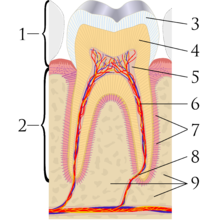
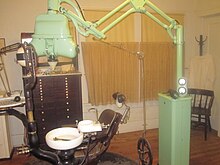
John M. Harris started the world's first dental school in
Studies show that dentists that graduated from different countries,
In the United Kingdom, the first dental schools, the
In many countries, dentists usually complete between five and eight years of post-secondary education before practising. Though not mandatory, many dentists choose to complete an internship or residency focusing on specific aspects of dental care after they have received their dental degree. In a few countries, to become a qualified dentist one must usually complete at least four years of postgraduate study;[26] Dental degrees awarded around the world include the Doctor of Dental Surgery (DDS) and Doctor of Dental Medicine (DMD) in North America (US and Canada), and the Bachelor of Dental Surgery/Baccalaureus Dentalis Chirurgiae (BDS, BDent, BChD, BDSc) in the UK and current and former British Commonwealth countries.
All dentists in the United States undergo at least three years of undergraduate studies, but nearly all complete a bachelor's degree. This schooling is followed by four years of dental school to qualify as a "
Specialties
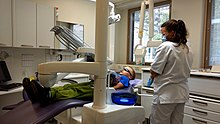
Some dentists undertake further training after their initial degree in order to specialize. Exactly which subjects are recognized by dental registration bodies varies according to location. Examples include:
- Cosmetic dentistry- Focuses on improving the appearance of the mouth, teeth and smile.
- Anesthesiology[28] – The specialty of dentistry that deals with the advanced use of general anesthesia, sedation and pain management to facilitate dental procedures.
- Dental public health – The study of epidemiology and social health policies relevant to oral health.
- dental pulpand periapical tissues.
- Forensic odontology – The gathering and use of dental evidence in law. This may be performed by any dentistwith experience or training in this field. The function of the forensic dentist is primarily documentation and verification of identity.
- Geriatric dentistry or geriodontics – The delivery of dental care to older adults involving the diagnosis, prevention, and treatment of problems associated with normal aging and age-related diseases as part of an interdisciplinary team with other health care professionals.
- Oral and maxillofacial pathology – The study, diagnosis, and sometimes the treatment of oral and maxillofacial related diseases.
- Oral and maxillofacial radiology – The study and radiologic interpretation of oral and maxillofacial diseases.
- Oral biology – Research in dental and craniofacial biology
- Oral Implantology– The art and science of replacing extracted teeth with dental implants.
- diseases
- Orthodontics and dentofacial orthopedics – The straightening of teeth and modification of midface and mandibular growth.
- Pediatric dentistry (also called pedodontics) – Dentistry for children
- Periodontology (also called periodontics) – The study and treatment of diseases of the periodontium (non-surgical and surgical) as well as placement and maintenance of dental implants
- Dentures, bridgesand the restoration of implants.
- Some prosthodontists super-specialize in cleft lip and palate or patients born with an underdeveloped ear (microtia). Today, most maxillofacial prosthodontists return function and esthetics to patients with acquired defects secondary to surgical removal of head and neck tumors, or secondary to trauma from war or motor vehicle accidents.
- Some prosthodontists super-specialize in
- Special needs dentistry (also called special care dentistry) – Dentistry for those with developmental and acquired disabilities.
- Sports dentistry – the branch of Sports MedicineTeam.
- Veterinary dentistry – The field of dentistry applied to the care of animals. It is a specialty of veterinary medicine.[30][31]
History
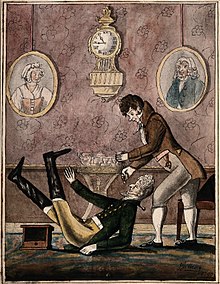
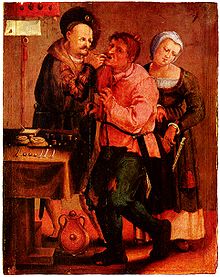
Tooth decay was low in
An ancient
Recipes for the treatment of toothache, infections and loose teeth are spread throughout the
During the Islamic Golden Age Dentistry was discussed in several famous books of medicine such as The Canon in medicine written by Avicenna and Al-Tasreef by Al-Zahrawi who is considered the greatest surgeon of the Middle Ages,[52] Avicenna said that jaw fracture should be reduced according to the occlusal guidance of the teeth; this principle is still valid in modern times. Al-Zahrawi invented over 200 surgical tools that resemble the modern kind.[53]
Historically, dental extractions have been used to treat a variety of illnesses. During the Middle Ages and throughout the 19th century, dentistry was not a profession in itself, and often dental procedures were performed by barbers or general physicians. Barbers usually limited their practice to extracting teeth which alleviated pain and associated chronic tooth infection. Instruments used for dental extractions date back several centuries. In the 14th century, Guy de Chauliac most probably invented the dental pelican[54] (resembling a pelican's beak) which was used to perform dental extractions up until the late 18th century. The pelican was replaced by the dental key[55] which, in turn, was replaced by modern forceps in the 19th century.[56]
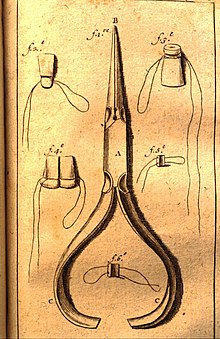
The first book focused solely on dentistry was the "Artzney Buchlein" in 1530,[46] and the first dental textbook written in English was called "Operator for the Teeth" by Charles Allen in 1685.[23]
In the United Kingdom, there was no formal qualification for the providers of dental treatment until 1859 and it was only in 1921 that the practice of dentistry was limited to those who were professionally qualified. The Royal Commission on the National Health Service in 1979 reported that there were then more than twice as many registered dentists per 10,000 population in the UK than there were in 1921.[57]
Modern dentistry
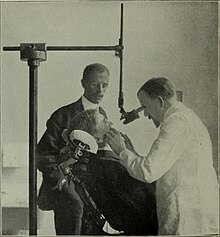
It was between 1650 and 1800 that the science of modern dentistry developed. The English physician Thomas Browne in his A Letter to a Friend (c. 1656 pub. 1690) made an early dental observation with characteristic humour:
The Egyptian Mummies that I have seen, have had their Mouths open, and somewhat gaping, which affordeth a good opportunity to view and observe their Teeth, wherein 'tis not easie to find any wanting or decayed: and therefore in Egypt, where one Man practised but one Operation, or the Diseases but of single Parts, it must needs be a barren Profession to confine unto that of drawing of Teeth, and little better than to have been Tooth-drawer unto King Pyrrhus, who had but two in his Head.
The French surgeon

Fauchard was the pioneer of dental prosthesis, and he invented many methods to replace lost teeth. He suggested that substitutes could be made from carved blocks of ivory or bone. He also introduced dental braces, although they were initially made of gold, he discovered that the teeth position could be corrected as the teeth would follow the pattern of the wires. Waxed linen or silk threads were usually employed to fasten the braces. His contributions to the world of dental science consist primarily of his 1728 publication Le chirurgien dentiste or The Surgeon Dentist. The French text included "basic oral anatomy and function, dental construction, and various operative and restorative techniques, and effectively separated dentistry from the wider category of surgery".[58][59]
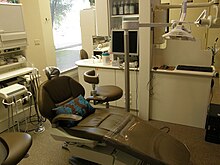
After Fauchard, the study of dentistry rapidly expanded. Two important books, Natural History of Human Teeth (1771) and Practical Treatise on the Diseases of the Teeth (1778), were published by British surgeon
Major advances in science were made in the 19th century, and dentistry evolved from a trade to a profession. The profession came under government regulation by the end of the 19th century. In the UK, the Dentist Act was passed in 1878 and the British Dental Association formed in 1879. In the same year, Francis Brodie Imlach was the first ever dentist to be elected President of the Royal College of Surgeons (Edinburgh), raising dentistry onto a par with clinical surgery for the first time.[61]
Hazards in modern dentistry
Long term occupational noise exposure can contribute to permanent hearing loss, which is referred to as
Within the field of dentistry, a variety of cleaning tools are used including piezoelectric and sonic scalers, and ultrasonic scalers and cleaners.[64] While a majority of the tools do not exceed 75 dBA,[65] prolonged exposure over many years can lead to hearing loss or complaints of tinnitus.[66] Few dentists have reported using personal hearing protective devices,[67][68] which could offset any potential hearing loss or tinnitus.
Evidence-based dentistry
There is a movement in modern dentistry to place a greater emphasis on high-quality scientific evidence in decision-making.
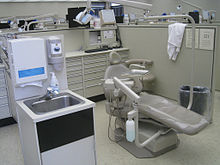
Ethical and medicolegal issues
Dentistry is unique in that it requires dental students to have competence-based clinical skills that can only be acquired through supervised specialized laboratory training and direct patient care.[70] This necessitates the need for a scientific and professional basis of care with a foundation of extensive research-based education.[71] According to some experts, the accreditation of dental schools can enhance the quality and professionalism of dental education.[72][73]
See also
Notes
- ^ Whether Dentists are referred to as "Doctor" is subject to geographic variation. For example, they are called "Doctor" in the US. In the UK, dentists have traditionally been referred to as "Mister" as they identified themselves with barber surgeons more than physicians (as do surgeons in the UK, see Surgeon#Titles). However more UK dentists now refer to themselves as "Doctor", although this was considered to be potentially misleading by the British public in a single report (see Costley and Fawcett 2010).
- ^ The scope of Oral and maxillofacial surgery is variable. In some countries, both a medical and dental degree is required for training, and the scope includes head and neck oncology and craniofacial deformity.
References
- ^ Neil Costley; Jo Fawcett (November 2010). General Dental Council Patient and Public Attitudes to Standards for Dental Professionals, Ethical Guidance and Use of the Term Doctor (PDF) (Report). General Dental Council/George Street Research. Archived from the original (PDF) on 4 March 2016. Retrieved 11 January 2017.
- ^ "Glossary of Dental Clinical and Administrative Terms". American Dental Association. Archived from the original on 6 March 2016. Retrieved 1 February 2014.
- ^ a b "Stone age man used dentist drill". BBC News. 6 April 2006. Retrieved 24 May 2010.
- PMID 2129621.
- ^ "When barbers were surgeons and surgeons were barbers". Radio National. 15 April 2015. Retrieved 10 September 2021.
- ^ "dentistry". Etymonline.com. Retrieved 17 May 2018.
- ^ PMID 25810982.
- ^ "What is the burden of oral disease?". WHO. Archived from the original on 30 June 2004. Retrieved 6 June 2017.
- ^ "American Academy of Cosmetic Dentistry | Dental CE Courses". aacd.com. Retrieved 21 October 2019.
- ^ a b c "Diagnosis of Celiac Disease". National Institute of Health (NIH). Archived from the original on 15 May 2017. Retrieved 6 June 2017.
{{cite web}}: CS1 maint: bot: original URL status unknown (link) - ^ Dental Enamel Defects and Celiac Disease Archived March 5, 2016, at the Wayback Machine National Institute of Health (NIH)
- S2CID 205776755.
- PMID 20478802.
- PMID 20478800.
- ^ Owen, Lorrie K., ed. Dictionary of Ohio Historic Places. Vol. 2. St. Clair Shores: Somerset, 1999, 1217–1218.
- OCLC 958458166.
- ^ "History". Pennsylvania School of Dental Medicine. Retrieved 13 January 2016.
- PMID 18172239.
- PMID 16886872.
- PMID 17368360.
- PMID 16562330.
- ^ a b Gelbier, Stanley. 125 Years of Developments in Dentistry. British Dental Journal (2005); 199, 470–73. The 1879 register is referred to as the "Dental Register".
- ^ a b The story of dentistry: Dental History Timeline Archived 9 March 2012 at the Wayback Machine, hosted on the British Dental Association website. Page accessed 2 March 2010.
- The Glasgow Herald. p. 3. Retrieved 5 April 2017.
- ^ History of Dental Surgery in Edinburgh (PDF), hosted on the Royal College of Surgeons of Edinburgh website. Page accessed 11 December 2007.
- ^ "Dentistry (D.D.S. or D.M.D.)" (PDF). Purdue.edu. Archived from the original (PDF) on 9 January 2017. Retrieved 17 May 2018.
- ^ "Canadian Dental Association". cda-adc.ca. Retrieved 21 October 2019.
- ^ "Anesthesiology recognized as a dental specialty". www.ada.org. Archived from the original on 21 September 2019. Retrieved 12 March 2019.
- ^ "Sports dentistry". FDI World Dental Federation. Archived from the original on 23 October 2020. Retrieved 13 July 2020.
- ^ "AVDC Home". Avdc.org. 29 November 2009. Retrieved 18 April 2010.
- ^ "EVDC web site". Evdc.info. Archived from the original on 5 September 2018. Retrieved 18 April 2010.
- ^ Barras, Colin (29 February 2016). "How our ancestors drilled rotten teeth". BBC. Archived from the original on 19 May 2017. Retrieved 1 March 2016.
- ^ "Oldest Dentistry Found in 14,000-Year-Old Tooth". Discovery Channel. 16 July 2015. Archived from the original on 18 July 2015. Retrieved 21 July 2015.
- ^ "Analysis of Neanderthal teeth marks uncovers evidence of prehistoric dentistry". The University of Kansas. 28 June 2017. Retrieved 1 July 2017.
- ^ Coppa, A. et al. 2006. "Early Neolithic tradition of dentistry" (PDF). Nature. Volume 440. 6 April 2006.
- ^ NBC News (2008). Dig uncovers ancient roots of dentistry.
- PMID 23028670.
- ^ "700 years added to Malta's history". Times of Malta. 16 March 2018. Archived from the original on 16 March 2018.
- ^ "History of Dentistry: Ancient Origins". American Dental Association. Archived from the original on 5 July 2007. Retrieved 9 January 2007.
- JSTOR 44442797.
- PMID 2129621. Archived from the original(PDF) on 18 December 2007.
- ^ PMID 24665522.
- ^ Ancient Egyptian Dentistry, hosted on the University of Oklahoma website. Page accessed 15 December 2007. Version archived by the Wayback Machine on 26 December 2007.
- ^ Wilwerding, Terry. "History of Dentistry 2001" (PDF). Archived from the original (PDF) on 3 November 2014. Retrieved 3 November 2014.
- ^ "Medicine in Ancient Egypt 3". Arabworldbooks.com. Retrieved 18 April 2010.
- ^ a b "History Of Dentistry". Complete Dental Guide. Archived from the original on 14 July 2016. Retrieved 29 June 2016.
- ^ "History of Dentistry Research Page, Newsletter". Rcpsg.ac.uk. Archived from the original on 28 April 2015. Retrieved 9 June 2014.
- ISBN 978-0-500-28976-1.
- ^ "Dental Treatment in the Ancient Times". Dentaltreatment.org.uk. Archived from the original on 1 December 2009. Retrieved 18 April 2010.
- PMID 2694433.
- ^ Czarnetzki, A.; Ehrhardt S. (1990). "Re-dating the Chinese amalgam-filling of teeth in Europe". International Journal of Anthropology. 5 (4): 325–32.
- ISBN 978-0-415-96690-0.
- ISBN 0786451343.
- ^ Gregory Ribitzky. "Pelican". Retrieved 23 June 2018.
- ^ Gregory Ribitzky. "Toothkey". Retrieved 23 June 2018.
- ^ Gregory Ribitzky. "Forceps". Retrieved 23 June 2018.
- ISBN 978-0-10-176150-5. Retrieved 19 May 2015.
- ^ a b André Besombes; Phillipe de Gaillande (1993). Pierre Fauchard (1678–1761): The First Dental Surgeon, His Work, His Actuality. Pierre Fauchard Academy.
- ^ a b Bernhard Wolf Weinberger (1941). Pierre Fauchard, Surgeon-dentist: A Brief Account of the Beginning of Modern Dentistry, the First Dental Textbook, and Professional Life Two Hundred Years Ago. Pierre Fauchard Academy.
- ISBN 978-1-4090-4462-8. Retrieved 8 March 2012.
- ^ Dingwall, Helen (April 2004). "A pioneering history: dentistry and the Royal College of Surgeons of Edinburgh" (PDF). History of Dentistry Newsletter. No. 14. Archived from the original (PDF) on 1 February 2013.
- ^ "Noise-Induced Hearing Loss". NIDCD. 18 August 2015.
- ^ "Occupational Safety and Health Standards | Occupational Safety and Health Administration". Osha.gov.
- ^ Stevens, M (1999). "Is someone listening to the din of occupational noise exposure in dentistry". RDH (19): 34–85.
- ^ Merrel, HB (1992). "Noise pollution and hearing loss in the dental office". Dental Assisting Journal. 61 (3): 6–9.
- PMID 12592917.
- (PDF) from the original on 27 April 2019.
- PMID 11326443.
- PMID 1404801.
- ^ "Union workers build high-tech dental simulation laboratory for SIU dental school". The Labor Tribune. 17 March 2014. Retrieved 10 September 2021.
- PMID 22262547.
- PMID 18250379.
- ^ Carrrassi, A. (2019). "The first 25 year [Internet] Ireland: ADEE (Association for Dental Education in Europe)". Association for Dental Education in Europe. Retrieved 21 October 2019.
External links
- Dentistry at Curlie
